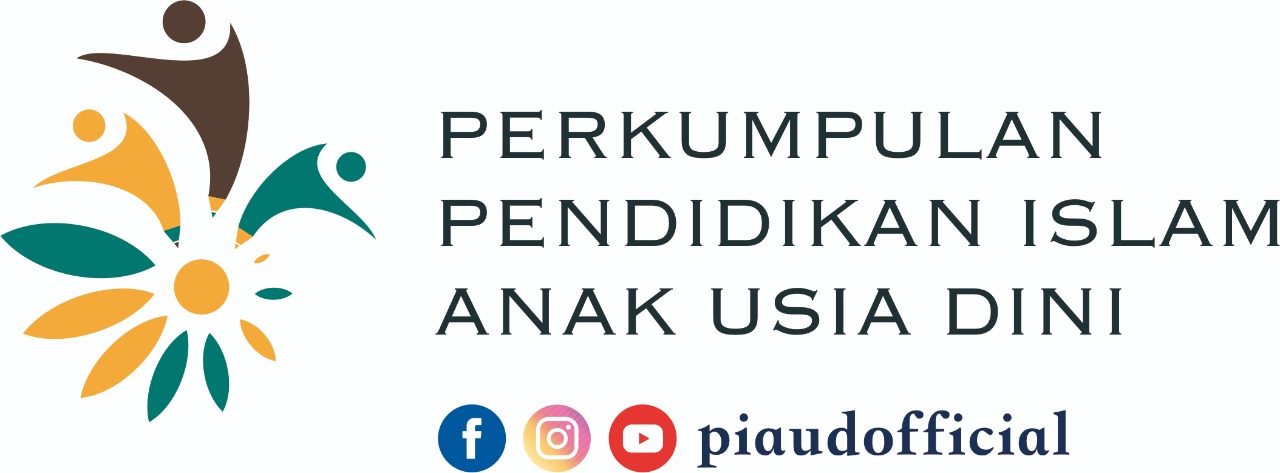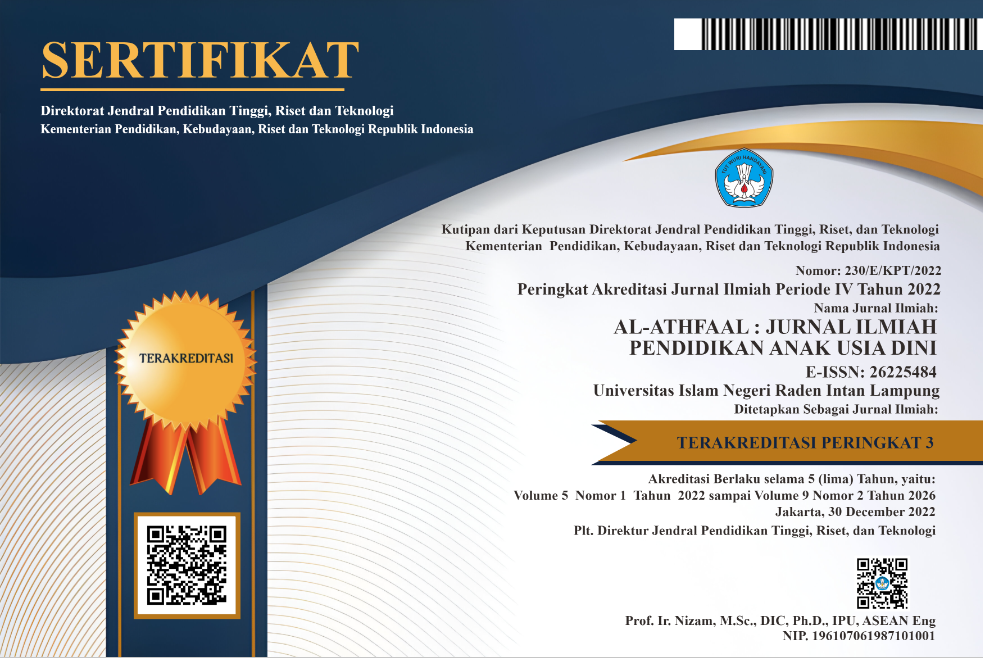Analysis of parents' sex education towards ABK children in SLB Lampung province
Abstract
Background: This study analyzes the role of parents in providing sex education to children with special needs (CWSN) in Special Schools (SLB) in Lampung Province. The focus is on empowering CWSN with knowledge about personal boundaries and self-protection to prevent sexual abuse. Despite its significance, sex education in Indonesia faces challenges, including limited parental knowledge and societal stigma.
Aim: The research aims to explore parental roles, strategies, and challenges in delivering sex education, providing recommendations for effective and inclusive approaches tailored to the needs of CWSN.
Method: A qualitative approach with a descriptive design was employed. Data were collected through in-depth interviews, participant observation, and documentation from 15 parents of CWSN aged 6–12 years. Triangulation ensured data validity, and analysis followed Miles and Huberman’s model, focusing on data reduction, presentation, and conclusion drawing.
Results: Parents typically begin sex education after children reach 10 years, focusing on topics like sexual abuse prevention, physical boundaries, and gender identity. Family discussions were the most common strategy, with visual aids used selectively. Challenges included cultural stigma, resource limitations, and lack of institutional support.
Conclusion: To enhance sex education for CWSN, earlier introduction using age-appropriate methods is recommended. Collaboration among parents, educators, and policymakers, along with resources like training programs and educational media, is crucial. These efforts can foster holistic development and protection for CWSN in Indonesia
Keywords
Full Text:
PDFReferences
Alaggia, R., Collin-Vézina, D., & Lateef, R. (2019). Facilitators and barriers to child sexual abuse (CSA) disclosures: A research update (2000–2016). Trauma, Violence, & Abuse, 20(2), 260–283. https://doi.org/10.1177/1524838017697312
Anisah, A. (2023). Implementation strengthening education character student school Al-Anwar’s foundations through school culture. Assyfa Journal of Islamic Studies, 1(1). https://doi.org/10.61650/ajis.v1i1.296
Arnab, S., Brown, K., Clarke, S., Dunwell, I., Lim, T., Suttie, N., Louchart, S., Hendrix, M., & de Freitas, S. (2013). The development approach of a pedagogically-driven serious game to support relationship and sex education (RSE) within a classroom setting. Computers & Education, 69, 15–30. https://doi.org/10.1016/j.compedu.2013.06.013
Arnardóttir, A. (2011). The right to inclusive education for children with disabilities – Innovations in the CRPD. In Making Peoples Heard (pp. 197–227). Brill | Nijhoff. https://doi.org/10.1163/9789004215801_014
Auerbach, E. (1995). Deconstructing the discourse of strengths in family literacy. Journal of Reading Behavior, 27(4), 643–661. https://doi.org/10.1080/10862969509547903
Bachen, C. M., Hernández-Ramos, P. F., & Raphael, C. (2012). Simulating REAL LIVES. Simulation & Gaming, 43(4), 437–460. https://doi.org/10.1177/1046878111432108
Bastien, S., Kajula, L., & Muhwezi, W. (2011). A review of studies of parent-child communication about sexuality and HIV/AIDS in sub-Saharan Africa. Reproductive Health, 8(1), 25. https://doi.org/10.1186/1742-4755-8-25
Bradley, E. H., Curry, L. A., & Devers, K. J. (2007). Qualitative data analysis for health services research: Developing taxonomy, themes, and theory. Health Services Research, 42(4), 1758–1772. https://doi.org/10.1111/j.1475-6773.2006.00684.x
Braeken, D., & Rondinelli, I. (2012). Sexual and reproductive health needs of young people: Matching needs with systems. International Journal of Gynecology & Obstetrics, 119(S1). https://doi.org/10.1016/j.ijgo.2012.03.019
Breuner, C. C., Mattson, G., Breuner, C. C., Adelman, W. P., Alderman, E. M., Garofalo, R., Marcell, A. V., Powers, M. E., Upadhya, K. K., Yogman, M. W., Bauer, N. S., Gambon, T. B., Lavin, A., Lemmon, K. M., Rafferty, J. R., & Wissow, L. S. (2016). Sexuality education for children and adolescents. Pediatrics, 138(2). https://doi.org/10.1542/peds.2016-1348
Camelia, L., & Nirmala, I. (2016). Prevention of violence and sexual abuse in early childhood through implementation of sex education in the perspective of the Sunnah. Indonesian Journal of Islamic Early Childhood Education, 1(1), 27–34. https://doi.org/10.51529/ijiece.v1i1.34
Carolina, N., Saputra, W. A., Nafi’ah, H. H., Merkuri, Y. G., & Bakti, C. P. (2022). Strategi intervensi untuk menekan kasus kekerasan seksual: Isu dan tren. Jurnal Mahasiswa BK An-Nur: Berbeda, Bermakna, Mulia, 8(2), 60. https://doi.org/10.31602/jmbkan.v8i2.7098
Collins, D., & Coleman, T. (2008). Social geographies of education: Looking within, and beyond, school boundaries. Geography Compass, 2(1), 281–299. https://doi.org/10.1111/j.1749-8198.2007.00081.x
Crabbe, M., & Flood, M. (2021). School-based education to address pornography’s influence on young people: A proposed practice framework. American Journal of Sexuality Education, 16(1), 1–37. https://doi.org/10.1080/15546128.2020.1856744
Craig, E. (2022). Teaching safeguarding through books: A content analysis of child sexual abuse prevention books. Journal of Child Sexual Abuse, 31(3), 257–275. https://doi.org/10.1080/10538712.2021.1985672
Crooks, N., Sosina, W., Debra, A., Sanker-Panchal, K., Okafor, A., Coleman, D., & Barrie, R. (2024). ‘Protecting your body and loving yourself’: Strategies Black male caregivers use to protect Black girls’ sexuality in the USA. Culture, Health & Sexuality, 1–17. https://doi.org/10.1080/13691058.2024.2355206
Dawson, K., Nic Gabhainn, S., & MacNeela, P. (2020). Toward a model of porn literacy: Core concepts, rationales, and approaches. The Journal of Sex Research, 57(1), 1–15. https://doi.org/10.1080/00224499.2018.1556238
Ebrahim, H. B., Martin, C., & Excell, L. (2021). Early childhood teachers’ and managers’ lived experiences of the COVID-19 pandemic in South Africa. Journal of Education, 84, 1–18. https://doi.org/10.17159/2520-9868/i84a11
Fakhiratunnisa, S. A., Pitaloka, A. A. P., & Ningrum, T. K. (2022). Konsep dasar anak berkebutuhan khusus. Masaliq, 2(1), 26–42. https://doi.org/10.58578/masaliq.v2i1.83
Flaspohler, P. D., Meehan, C., Maras, M. A., & Keller, K. E. (2012). Ready, willing, and able: Developing a support system to promote implementation of school-based prevention programs. American Journal of Community Psychology, 50(3–4), 428–444. https://doi.org/10.1007/s10464-012-9520-z
Goldman, J. D. G. (2008). Responding to parental objections to school sexuality education: A selection of 12 objections. Sex Education, 8(4), 415–438. https://doi.org/10.1080/14681810802433952
Guse, K., Levine, D., Martins, S., Lira, A., Gaarde, J., Westmorland, W., & Gilliam, M. (2012). Interventions using new digital media to improve adolescent sexual health: A systematic review. Journal of Adolescent Health, 51(6), 535–543. https://doi.org/10.1016/j.jadohealth.2012.03.014
Huaynoca, S., Chandra-Mouli, V., Yaqub Jr., N., & Denno, D. M. (2014). Scaling up comprehensive sexuality education in Nigeria: From national policy to nationwide application. Sex Education, 14(2), 191–209. https://doi.org/10.1080/14681811.2013.856292
Ip, H. H. S., Wong, S. W. L., Chan, D. F. Y., Byrne, J., Li, C., Yuan, V. S. N., Lau, K. S. Y., & Wong, J. Y. W. (2018). Enhance emotional and social adaptation skills for children with autism spectrum disorder: A virtual reality enabled approach. Computers & Education, 117, 1–15. https://doi.org/10.1016/j.compedu.2017.09.010
Janssens, A., Blake, S., Allwood, M., Ewing, J., & Barlow, A. (2020). Exploring the content and delivery of relationship skills education programmes for adolescents: A systematic review. Sex Education, 20(5), 494–516. https://doi.org/10.1080/14681811.2019.1697661
Kartel, A., Charles, M., Xiao, H., & Sundi, D. (2022). Strategies for parent involvement during distance learning in Arabic lessons in elementary schools. Journal International of Lingua and Technology, 1(2), 99–113. https://doi.org/10.55849/jiltech.v1i2.82
Kendall-Tackett, K. A., Finkelhor, D., & Wilcox, M. L. (n.d.). Impact of sexual abuse on children: A review and synthesis of recent empirical studies. Psychological Bulletin, 113(1).
Kenny, M. C., Capri, V., Thakkar‐Kolar, R., Ryan, E. E., & Runyon, M. K. (2008). Child sexual abuse: From prevention to self‐protection. Child Abuse Review, 17(1), 36–54. https://doi.org/10.1002/car.1012
Kumar, P., & Agrawal, N. (2019). Learning disabled and their education in India. Human Arenas, 2(2), 228–244. https://doi.org/10.1007/s42087-018-0035-5
Laksmi, I., Astiti, C., & Valentina, T. D. (2024). Kesejahteraan psikologis orang tua dengan anak berkebutuhan khusus: Literature review. Innovative: Journal of Social …, 4, 8214–8228. http://j-innovative.org/index.php/Innovative/article/view/8781
Lameiras-Fernández, M., Martínez-Román, R., Carrera-Fernández, M. V., & Rodríguez-Castro, Y. (2021). Sex education in the spotlight: What is working? Systematic review. International Journal of Environmental Research and Public Health, 18(5), 2555. https://doi.org/10.3390/ijerph18052555
Lehan Mackin, M., Loew, N., Gonzalez, A., Tykol, H., & Christensen, T. (2016). Parent perceptions of sexual education needs for their children with autism. Journal of Pediatric Nursing, 31(6), 608–618. https://doi.org/10.1016/j.pedn.2016.07.003
Leung, H., Shek, D. T. L., Leung, E., & Shek, E. Y. W. (2019). Development of contextually-relevant sexuality education: Lessons from a comprehensive review of adolescent sexuality education across cultures. International Journal of Environmental Research and Public Health, 16(4), 621. https://doi.org/10.3390/ijerph16040621
Liang, C. T. H., Rocchino, G. H., Gutekunst, M. H. C., Paulvin, C., Melo Li, K., & Elam-Snowden, T. (2020). Perspectives of respect, teacher–student relationships, and school climate among boys of color: A multifocus group study. Psychology of Men & Masculinities, 21(3), 345–356. https://doi.org/10.1037/men0000239
Maslahah, S., Prasadana, M. A. F., Kamila, A. N., & Septiandi, M. (2024). Sexual education for children with special needs through learning media based on universal design for learning. Proceeding of International Conference on Special Education in South East Asia Region, 3(1), 442–448. https://doi.org/10.57142/picsar.v3i1.590
Mathews, B., & Collin-Vézina, D. (2019). Child sexual abuse: Toward a conceptual model and definition. Trauma, Violence, & Abuse, 20(2), 131–148. https://doi.org/10.1177/1524838017738726
Messinger, P. R., Stroulia, E., Lyons, K., Bone, M., Niu, R. H., Smirnov, K., & Perelgut, S. (2009). Virtual worlds — Past, present, and future: New directions in social computing. Decision Support Systems, 47(3), 204–228. https://doi.org/10.1016/j.dss.2009.02.014
Mitra, S., Lakshmi, D., & Govindaraj, V. (2023). Data analysis and machine learning in AI-assisted special education for students with exceptional needs (pp. 67–109). https://doi.org/10.4018/979-8-3693-0378-8.ch004
Mohd. Tohit, N. F., & Haque, M. (2024). Forbidden conversations: A comprehensive exploration of taboos in sexual and reproductive health. Cureus. https://doi.org/10.7759/cureus.66723
Mondal, A., & Islam, N. (2023). The Right to Education Act, 2009 in India after a decade: Appraising achievements and exploring unkept promises. Education 3-13, 51(1), 87–106. https://doi.org/10.1080/03004279.2021.1973532
Moreira, M. T., Rocha, E., Lima, A., Pereira, L., Rodrigues, S., & Fernandes, C. S. (2023). Knowledge about sex education in adolescence: A cross-sectional study. Adolescents, 3(3), 431–445. https://doi.org/10.3390/adolescents3030030
Neal, J. W., & Neal, Z. P. (2013). Nested or networked? Future directions for ecological systems theory. Social Development, 22(4), 722–737. https://doi.org/10.1111/sode.12018
P.R., R., & Jose, J. (2024). Empowering children with special needs (CwSN) in computer science: An interactive hand gestures approach to number conversion teaching. Journal of Educational Technology Development and Exchange, 17(2), 254–274. https://doi.org/10.18785/jetde.1702.12
Pratiwi, H., Ismail, M., & Riwanda, A. (2024). Questioning inclusive city quality: Teachers’ perspectives and experiences in sexuality education for children with special needs in Indonesia. International Journal of Educational Research, 127, 102419. https://doi.org/10.1016/j.ijer.2024.102419
Rakhmawati, E., Yuliejatiningsih, Y., & Rakhmawati, D. (2024). Sexual psychoeducation of pre-school children: Teachers’ strategies and barriers in teaching self-protection. Bulletin of Counseling and Psychotherapy, 6(1). https://doi.org/10.51214/00202406839000
Robinson, K. H. (2012). ‘Difficult citizenship’: The precarious relationships between childhood, sexuality, and access to knowledge. Sexualities, 15(3–4), 257–276. https://doi.org/10.1177/1363460712436469
Roth, R., Abraham, J., Zinzow, H., Wisniewski, P., Khasawneh, A., & Chalil Madathil, K. (2020). Evaluating news media reports on the “Blue Whale Challenge” for adherence to suicide prevention safe messaging guidelines. Proceedings of the ACM on Human-Computer Interaction, 4(CSCW1), 1–27. https://doi.org/10.1145/3392831
Santa Maria, D., Markham, C., Bluethmann, S., & Mullen, P. D. (2015). Parent‐based adolescent sexual health interventions and effect on communication outcomes: A systematic review and meta‐analyses. Perspectives on Sexual and Reproductive Health, 47(1), 37–50. https://doi.org/10.1363/47e2415
ST Aisyah BM, & AB, S. (2022). Persuasive dakwah on the development of ex-commercial sex workers in the Mattirodeceng Women’s Social Organization Makassar City (A sociological approach). International Journal of Social Science and Human Research, 05(08), 3784–3791. https://doi.org/10.47191/ijsshr/v5-i8-55
Suartana, I. K. A. (2024). Criminal law enforcement against perpetrators of sexual intercourse with biological children. Journal of Social Research, 3(9). https://doi.org/10.55324/josr.v3i9.2245
Tharinger, D., Horton, C. B., & Millea, S. (1990). Sexual abuse and exploitation of children and adults with mental retardation and other handicaps. Child Abuse & Neglect, 14(3), 301–312. https://doi.org/10.1016/0145-2134(90)90002-B
To, S., Ngai, S. S., & Iu Kan, S. (2012). Direct and mediating effects of accessing sexually explicit online materials on Hong Kong adolescents’ attitude, knowledge, and behavior relating to sex. Children and Youth Services Review, 34(11), 2156–2163. https://doi.org/10.1016/j.childyouth.2012.07.019
UNICEF. (2020). Global status report on preventing violence against children 2020. https://www.who.int/publications-detail-redirect/9789240004191
Vairamani, A. D. (2024). Enhancing social skills development through augmented reality (AR) and virtual reality (VR) in special education. In Augmented Reality and Virtual Reality in Special Education (pp. 65–89). Wiley. https://doi.org/10.1002/9781394167586.ch3
Valentine, G. (1997). “Oh yes I can.” “Oh no you can’t”: Children and parents’ understandings of kids’ competence to negotiate public space safely. Antipode, 29(1), 65–89. https://doi.org/10.1111/1467-8330.00035
Walker, J. (2004). Parents and sex education—looking beyond ‘the birds and the bees.’ Sex Education, 4(3), 239–254. https://doi.org/10.1080/1468181042000243330
Widaningsih, A., Setyaningrum, T., & Subekti, S. (n.d.). Integration of sex education in special needs schools in Indonesia. Journal of Special Education Research, 12(4).
DOI: http://dx.doi.org/10.24042/al-athfaal.v7i2.24607
Refbacks
- There are currently no refbacks.
Copyright (c) 2024 Al-Athfaal: Jurnal Ilmiah Pendidikan Anak Usia Dini
License URL: https://creativecommons.org/licenses/by-sa/4.0
 Semua publikasi Al-Athfaal: Jurnal Ilmiah Pendidikan Anak Usia Dini [p-ISSN: 2622-5484, e-ISSN: 2622-5182] dilisensikan di bawah Lisensi Internasional Creative Commons Atribusi-BerbagiSerupa 4.0.
Semua publikasi Al-Athfaal: Jurnal Ilmiah Pendidikan Anak Usia Dini [p-ISSN: 2622-5484, e-ISSN: 2622-5182] dilisensikan di bawah Lisensi Internasional Creative Commons Atribusi-BerbagiSerupa 4.0.











